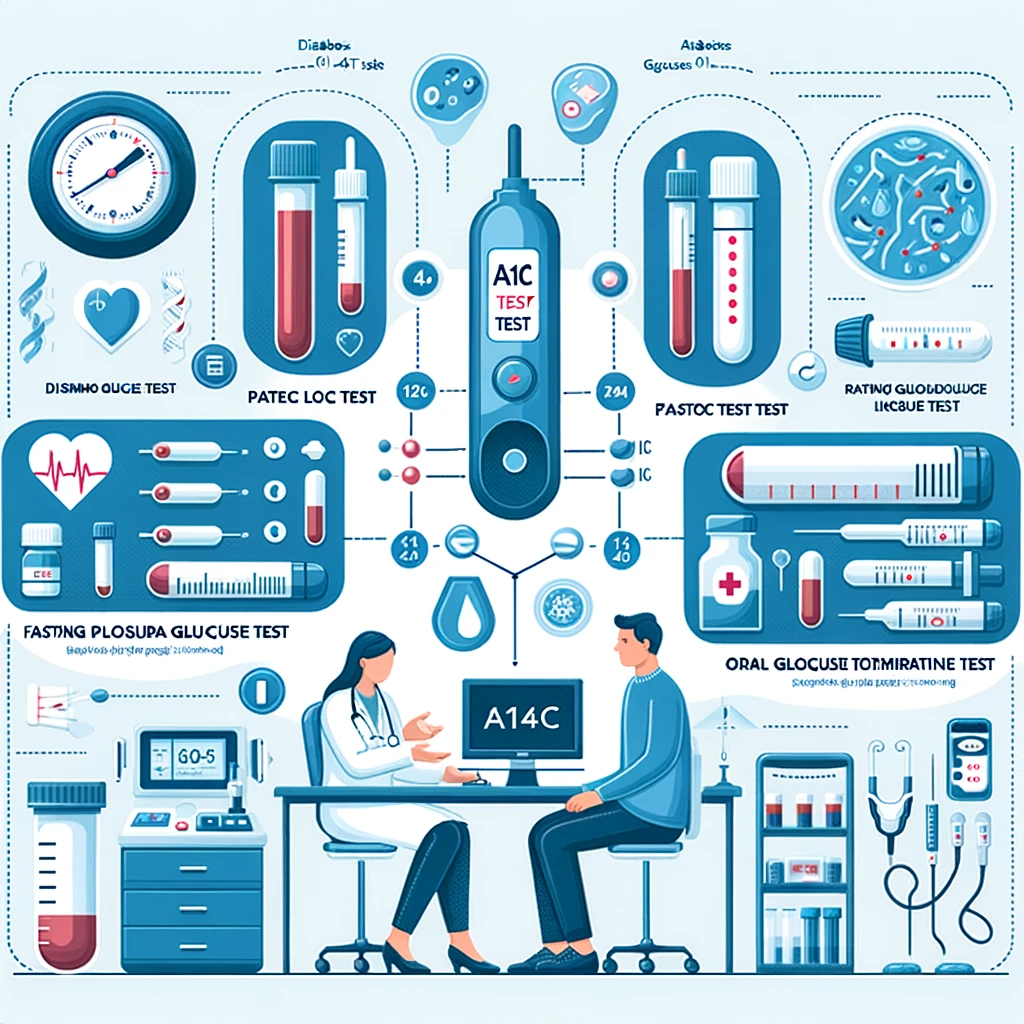Diabetes Diagnosis: What Tests Do You Need and What They Mean
Introduction
Diabetes is a global health concern, affecting millions of people worldwide. Early detection through proper diabetes diagnostic tests is crucial for effective management and prevention of complications. But how is diabetes diagnosed? What tests do doctors use to confirm the condition?
In this guide, we will explore the key tests used to diagnose diabetes, what they measure, and how to interpret the results. Whether you’re at risk of diabetes or simply looking to understand the diagnostic process, this article provides the insights you need.
Common Blood Tests for Diabetes Diagnosis
Doctors use several blood tests for diabetes diagnosis, each measuring different aspects of blood sugar control. Here are the most commonly used tests:
1. A1C Test for Diabetes (Glycated Hemoglobin Test)
The A1C test measures your average blood sugar levels over the past 2–3 months by analyzing the percentage of hemoglobin that is glycated (coated with sugar).
A1C Levels in Diabetes Diagnosis:
- Normal: Below 5.7%
- Prediabetes: 5.7% – 6.4%
- Diabetes: 6.5% or higher
Why it’s important: This test helps diagnose both Type 1 and Type 2 diabetes and is also used to monitor blood sugar control in people already diagnosed.
2. Fasting Plasma Glucose (FPG) Test
The Fasting Plasma Glucose test measures blood sugar levels after an overnight fast of at least 8 hours. It is one of the most common tests used for initial screening.
Interpreting Diabetes Test Results:
- Normal: Less than 100 mg/dL
- Prediabetes: 100 – 125 mg/dL
- Diabetes: 126 mg/dL or higher (confirmed by a second test)
Why it’s important: The FPG test provides a clear indication of how your body manages blood sugar when fasting, making it useful for diagnosing diabetes.
3. Oral Glucose Tolerance Test (OGTT)
The Oral Glucose Tolerance Test (OGTT) evaluates how your body processes sugar over time. After fasting overnight, you consume a sugary drink, and blood sugar levels are tested at intervals over two hours.
Results:
- Normal: Less than 140 mg/dL
- Prediabetes: 140 – 199 mg/dL
- Diabetes: 200 mg/dL or higher
Why it’s important: The OGTT is particularly effective for diagnosing gestational diabetes (diabetes during pregnancy) and detecting prediabetes.
4. Random Plasma Glucose (RPG) Test
Unlike the FPG test, the Random Plasma Glucose test does not require fasting. Instead, it measures blood sugar levels at any random time of the day.
Diabetes Diagnosis Criteria:
- A reading of 200 mg/dL or higher, along with symptoms of diabetes (such as excessive thirst, frequent urination, and fatigue), indicates diabetes.
Why it’s important: This test is often used in urgent situations when symptoms suggest diabetes and immediate diagnosis is necessary.
Prediabetes Diagnostic Criteria
Prediabetes is a condition where blood sugar levels are higher than normal but not high enough to be classified as diabetes. Early detection is crucial to prevent the progression to Type 2 diabetes.
Diabetes Screening Guidelines for Prediabetes:
- A1C Test: 5.7% – 6.4%
- Fasting Plasma Glucose Test: 100 – 125 mg/dL
- Oral Glucose Tolerance Test: 140 – 199 mg/dL
If you have prediabetes, lifestyle changes such as diet, exercise, and weight management can help prevent full-blown diabetes.
How to Prepare for Diabetes Testing
To ensure accurate results, follow these guidelines before your test:
- For fasting tests (FPG, OGTT): Do not eat or drink anything (except water) for 8–12 hours before the test.
- For A1C test: No special preparation is required.
- For OGTT: Be prepared to stay at the testing center for up to 2 hours after consuming the glucose drink.
What Happens After a Diabetes Diagnosis?
If your test results confirm diabetes, your doctor may recommend:
- Lifestyle modifications (healthy eating, physical activity, weight management)
- Regular blood sugar monitoring
- Medications or insulin therapy (depending on the type and severity of diabetes)
- Follow-up tests to monitor long-term blood sugar control
FAQs
What Is the Most Accurate Test for Diabetes?
The A1C test and Fasting Plasma Glucose test are considered the most reliable for diagnosing diabetes. The OGTT is particularly useful for detecting gestational diabetes.
Can Diabetes Be Diagnosed with Just One Test?
A single abnormal test result is not enough for a definitive diagnosis. Doctors usually require at least two abnormal test results on different days to confirm diabetes.
How Often Should I Get Tested for Diabetes?
- If you have risk factors (obesity, family history, high blood pressure), you should be tested at least once a year.
- If you are over 45, experts recommend routine screening every 3 years.
- If diagnosed with prediabetes, you should be tested annually.
Can I Lower My Blood Sugar Levels Naturally?
Yes! Eating a low-carb diet, increasing physical activity, reducing stress, and maintaining a healthy weight can significantly improve blood sugar control.
Conclusion
Early diagnosis of diabetes is critical for effective treatment and prevention of complications. Understanding the different diabetes diagnostic tests, what they measure, and how to interpret the results can help you take proactive steps toward your health.
If you suspect you have diabetes or are at risk, consult a healthcare provider and get tested today!
📩 Subscribe to our newsletter for more health insights and updates!
References
- American Diabetes Association (ADA) – Standards of Medical Care in Diabetes
- Centers for Disease Control and Prevention (CDC) – Diabetes Basics
- World Health Organization (WHO) – Diabetes Fact Sheet
- National Institute of Diabetes and Digestive and Kidney Diseases (NIDDK) – Diabetes Tests & Diagnosis
- Mayo Clinic – Diabetes Diagnosis and Treatment

Excellent work; your passion for the topic is evident.
Your storytelling skills make me wish I could be a character in your stories. You create such an captivating universe.